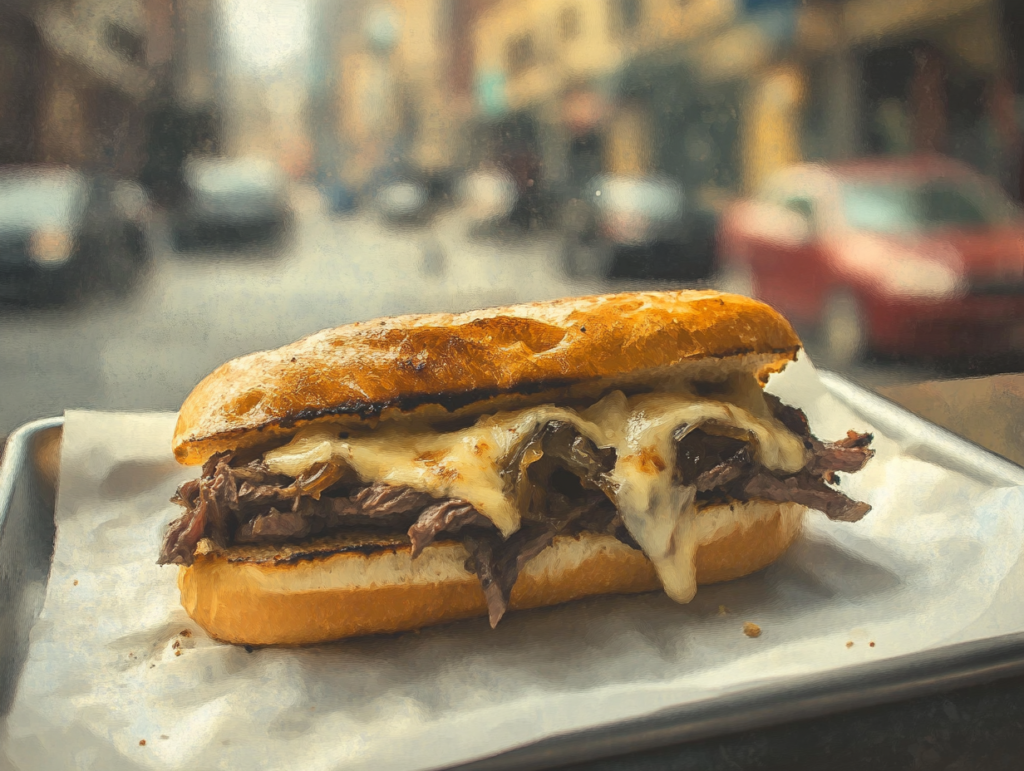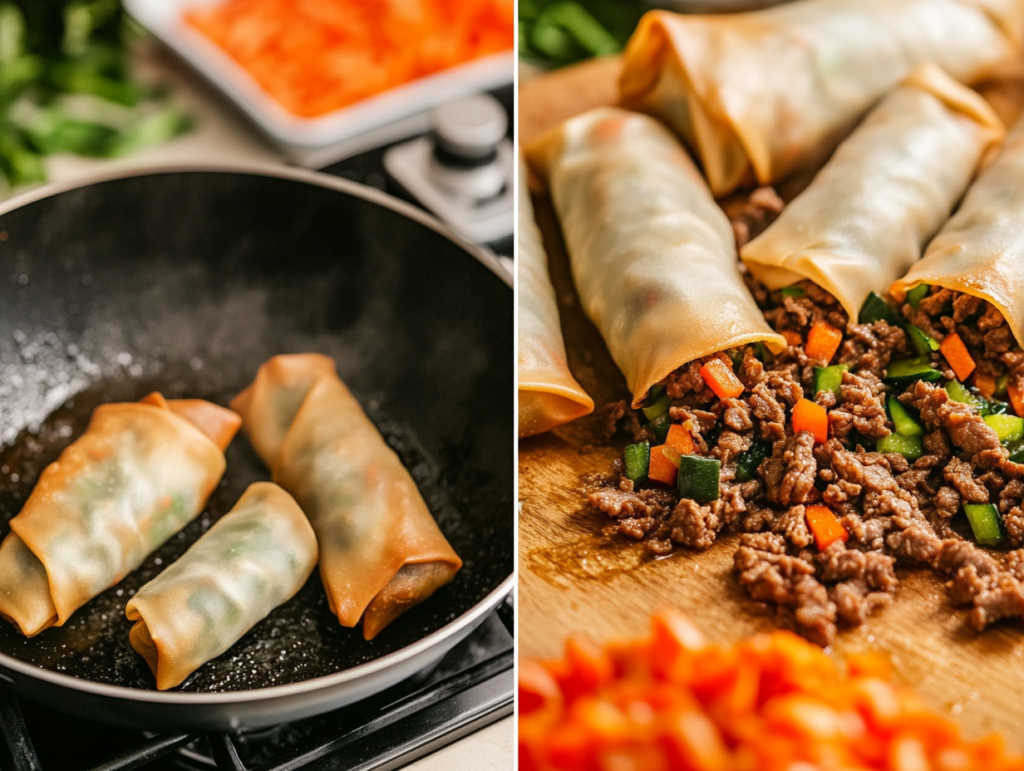Philly Cheesesteak Egg Rolls are a fusion dish combining the rich, savory flavors of the classic Philly cheesesteak with the crispy, portable appeal of Chinese-style egg rolls. This inventive appetizer or snack wraps thinly sliced steak, sautéed onions, bell peppers, and melted cheese in a crunchy egg roll wrapper. Perfect for dipping in sauces like cheese, marinara, or horseradish aioli, these egg rolls are a testament to the creative blending of culinary traditions.
Table of contents
History of the Philly Cheesesteak
The Philly cheesesteak has its roots in Philadelphia, Pennsylvania, dating back to the 1930s. It was first created by Pat Olivieri, a hot dog vendor who decided to grill thin slices of beef and serve them on a roll. Eventually, the addition of melted cheese came later, which ultimately evolved the sandwich into the iconic dish we know today. Typically made with thinly sliced ribeye steak, grilled onions, and cheese (often provolone, American, or the beloved Cheez Whiz), the Philly cheesesteak embodies the hearty, no-nonsense spirit of Philadelphia cuisine.

The Evolution of Egg Rolls in Fusion Cuisine
Egg rolls originated in Chinese-American cuisine, traditionally filled with cabbage, pork, or shrimp, and deep-fried to golden perfection. Over time, egg rolls have become a versatile canvas for culinary innovation. In the spirit of fusion cuisine—where different food traditions merge—chefs began experimenting with non-traditional fillings. This adaptability has turned egg rolls into a global food phenomenon, showcasing everything from Tex-Mex to dessert-inspired versions.
As a vehicle for creativity, the egg roll wrapper is ideal for combining familiar flavors with an unexpected twist, making it a favorite for innovative chefs and adventurous eaters.
Why Combine Philly Cheesesteak and Egg Rolls?
The idea of Philly Cheesesteak Egg Rolls exemplifies the magic of fusion cuisine. Here’s why this combination works so well:
- Flavor Synergy: The rich, umami flavors of cheesesteak ingredients pair harmoniously with the crunch and neutrality of an egg roll wrapper.
- Texture Contrast: The soft, juicy filling of steak, cheese, and onions is balanced by the crispiness of the fried wrapper, elevating the eating experience.
- Cultural Appeal: This dish merges American and Asian culinary elements, appealing to diverse palates and celebrating the creativity born from cultural crossroads.
- Portability: Cheesesteaks are beloved for their indulgence but can be messy. Egg rolls transform the cheesesteak into a convenient, handheld treat, perfect for parties or on-the-go enjoyment.
- Modern Palates: Fusion dishes resonate with contemporary diners seeking novelty without sacrificing comfort. Philly Cheesesteak Egg Rolls deliver the nostalgia of a cheesesteak with an exciting twist.
Philly Cheesesteak Egg Rolls are a celebration of culinary imagination, proving that great flavors transcend boundaries. By blending iconic American and Chinese-American traditions, they offer a unique dining experience that’s both familiar and delightfully unexpected.
Key Ingredients for Philly Cheesesteak Egg Rolls
Philly Cheesesteak Egg Rolls are a delightful fusion of classic cheesesteak flavors wrapped in a crispy egg roll shell. To perfect this dish, selecting the right ingredients is crucial. Here’s a breakdown of what makes these egg rolls shine:
Essential Ingredients: Beef, Cheese, and Veggies
- Beef
- Cut: Thinly sliced ribeye steak is the traditional choice for Philly cheesesteaks due to its marbling and tenderness. Alternatively, sirloin or flank steak can be used for a leaner option.
- Preparation: Cooked until tender and seasoned with salt, pepper, and optional garlic powder for added flavor.
- Cheese
- Varieties:
- Provolone: Offers a mild, creamy taste that melts beautifully.
- American: Smooth and rich, it’s a classic cheesesteak staple.
- Cheez Whiz: For an authentic Philly vibe, this processed cheese provides a tangy, gooey texture.
- Melting: Choose cheese that melts well to ensure a creamy filling.
- Varieties:
- Veggies
- Onions: Sautéed until caramelized, onions add sweetness and depth.
- Bell Peppers: While not traditional for cheesesteaks, they are a popular addition in variations. Use green, red, or yellow peppers for a burst of color and flavor.
- Optional Mushrooms: For an umami boost, finely chopped mushrooms can be sautéed with the onions.
Choosing the Perfect Wrapper
- Egg Roll Wrappers
- Thin and pliable, these wrappers are ideal for holding the filling securely while frying. They crisp up beautifully, providing the perfect contrast to the rich, savory filling.
- Tips for Use:
- Keep the wrappers moist by covering them with a damp cloth to prevent drying out.
- Seal the edges with a light egg wash or water to ensure no filling escapes during frying.
- Alternative Wrappers
- Spring roll wrappers: For a lighter, crispier texture.
- Wonton wrappers: Ideal for mini egg rolls or bite-sized appetizers.
Optional Ingredients to Elevate Flavor
- Sauces Inside
- Horseradish sauce: Adds a spicy kick.
- Worcestershire sauce: Infuses the filling with umami richness.
- Dijon mustard: Offers a tangy note that complements the cheese and beef.
- Seasonings
- Paprika, garlic powder, or onion powder can be used to enhance the flavor.
- Red pepper flakes or cayenne for a subtle heat.
- Fresh Herbs
- Chopped parsley or chives can brighten the filling and add a touch of freshness.
- Dipping Sauces
- While not part of the filling, pairing with dips like marinara, spicy ketchup, ranch, or a cheese sauce enhances the eating experience.
Summary
The perfect Philly Cheesesteak Egg Rolls rely on high-quality ingredients: tender beef, gooey cheese, and flavorful vegetables, all wrapped in a crispy egg roll shell. By carefully choosing your ingredients and adding optional enhancements like sauces or seasonings, you can elevate this dish into an irresistible fusion masterpiece.
Step-by-Step Guide to Making Philly Cheesesteak Egg Rolls
Making Philly Cheesesteak Egg Rolls is a straightforward process that combines classic cheesesteak ingredients with a crispy, portable wrapper. Follow these steps for the perfect fusion dish.
1. Prepping the Ingredients
Before cooking, gather and prepare all your ingredients for a smooth process.
- Beef
- Use thinly sliced ribeye, sirloin, or flank steak.
- Season with salt, pepper, and optional garlic powder.
- Chop the slices into smaller pieces to fit comfortably in the egg roll wrapper.
- Veggies
- Onions: Dice or thinly slice for even cooking.
- Bell Peppers: Optional, but chop them finely for a colorful and flavorful addition.
- Mushrooms: If using, clean and dice them into small pieces.
- Cheese
- Shred provolone or American cheese, or prepare Cheez Whiz for easy spreading.
- Egg Roll Wrappers
- Remove wrappers from the package and keep them covered with a damp towel to prevent drying.
2. Sautéing the Filling to Perfection
- Preheat a large skillet over medium-high heat and drizzle in a little oil.
- Cook the beef until browned and fully cooked, then set aside.
- In the same skillet, sauté the onions (and optional veggies like peppers or mushrooms) until softened and caramelized.
- Combine the cooked beef with the sautéed veggies in the skillet.
- Reduce heat to low and mix in the cheese, allowing it to melt and bind the filling. (Alternatively, add the cheese separately during assembly.)
- Let the filling cool slightly before wrapping to avoid tearing the wrappers.
3. Wrapping Techniques for Egg Rolls
Proper wrapping ensures the filling stays intact during frying or baking.
- Lay the Wrapper
- Place one wrapper on a flat surface in a diamond shape, with a corner pointing toward you.
- Add the Filling
- Spoon 2–3 tablespoons of the cooled filling onto the lower center of the wrapper. Avoid overfilling.
- Roll Tightly
- Fold the bottom corner up over the filling.
- Fold in the left and right corners toward the center, creating an envelope shape.
- Roll the wrapper tightly away from you, sealing the top corner with a dab of water or egg wash.
- Repeat
- Continue wrapping until all the filling is used, keeping the completed rolls covered with a damp cloth.

4. Frying vs. Baking: Which is Better?
Frying
- Method: Heat 2–3 inches of oil in a deep skillet or fryer to 350°F (175°C). Fry the egg rolls in batches for 3–5 minutes until golden brown, turning occasionally.
- Pros: Delivers the crispiest, most authentic texture.
- Cons: Higher in calories and requires more cleanup.
Baking
- Method: Preheat the oven to 400°F (200°C). Place egg rolls on a parchment-lined baking sheet, brush with oil or cooking spray, and bake for 15–20 minutes, turning halfway.
- Pros: Healthier and less messy.
- Cons: Slightly less crispy compared to frying.
Air Frying (Optional Alternative)
- Method: Preheat the air fryer to 375°F (190°C). Spray the rolls lightly with oil and air fry for 10–12 minutes, flipping halfway.
- Pros: Combines crispiness with a healthier cooking method.
- Cons: Limited capacity for larger batches.
Tips for Success
- Let fried rolls drain on a wire rack or paper towels to remove excess oil.
- Serve immediately for the best crunch and flavor.
- Pair with dipping sauces like cheese sauce, marinara, or spicy ketchup for added indulgence.
Common Mistakes to Avoid When Making Philly Cheesesteak Egg Rolls
Crafting the perfect Philly Cheesesteak Egg Rolls requires attention to detail. Here are some common pitfalls to avoid, ensuring your rolls turn out crisp, flavorful, and satisfying.
1. Overstuffing the Wrapper
Why It’s a Mistake
- Overloading the wrapper makes it difficult to seal, increasing the risk of the roll bursting open during cooking.
- Too much filling can also prevent the egg roll from cooking evenly.
How to Avoid It
- Use 2–3 tablespoons of filling per roll. This ensures the wrapper can close securely and fry or bake evenly.
- Distribute the filling in a compact, horizontal line to prevent bulkiness.
2. Undercooking or Overcooking the Meat
Why It’s a Mistake
- Undercooked Meat: Leaves the filling chewy and underwhelming.
- Overcooked Meat: Results in dry, tough beef that diminishes the dish’s overall appeal.
How to Avoid It
- Thin Slices: Use thinly sliced ribeye or sirloin, which cooks quickly and stays tender.
- Controlled Heat: Cook the meat over medium-high heat just until it browns; avoid leaving it on the heat for too long.
- Resting Period: Allow the meat to rest briefly before mixing with other ingredients to retain its juices.
3. Choosing the Wrong Cheese
Why It’s a Mistake
- The wrong cheese can alter the texture and flavor of the egg rolls.
- Hard Cheeses (e.g., cheddar) may not melt smoothly, leaving a clumpy filling.
- Overpowering Cheeses can dominate the flavor and overwhelm the delicate balance of the dish.
How to Avoid It
- Stick to cheeses that melt easily and complement the beefy, savory flavors:
- Provolone: A mild, creamy option that blends seamlessly.
- American Cheese: Smooth, gooey, and rich.
- Cheez Whiz: For an authentic Philly twist, this provides a creamy, tangy flavor.
Additional Tips to Avoid Common Errors
- Wrappers Breaking or Tearing
- Keep egg roll wrappers covered with a damp cloth to prevent them from drying out.
- Don’t over-moisten when sealing; too much water or egg wash can weaken the wrapper.
- Uneven Cooking
- If frying, ensure the oil is at the right temperature (350°F/175°C). Too hot, and the rolls may burn; too cold, and they’ll absorb excess oil.
- If baking, brush or spray the rolls with oil to achieve an even golden crust.
- Cold Filling
- Allow cooked filling to cool slightly before assembling to avoid steam softening the wrapper.
- Skipping Seasoning
- Season each element of the filling (meat, veggies) to enhance the overall flavor.
Related Articles You Might Like
If you’re a fan of innovative fusion dishes like Philly Cheesesteak Egg Rolls, you might also enjoy experimenting with other unique recipes. For dessert enthusiasts, check out the Brookie Recipe for a perfect blend of brownie and cookie in one delicious bite. If you’re curious about how this hybrid dessert is made, the guide What Are Brookies Made Of breaks down the essential components, while the detailed tutorial How to Assemble a Brookie Perfectly ensures flawless execution. These creative culinary ideas, much like the Philly Cheesesteak Egg Rolls, showcase how combining familiar elements can lead to extraordinary results.
FAQs About Philly Cheesesteak Egg Rolls
Traditional Philly cheesesteaks are served on Amoroso rolls, a soft and slightly chewy Italian roll. These rolls are beloved for holding the juicy steak, melted cheese, and toppings without becoming soggy. While egg rolls use a crispy wrapper instead of bread, they replicate the portability and satisfaction of the classic sandwich.
The exact origin of Philly Cheesesteak Egg Rolls isn’t documented, but the dish likely emerged as a creative fusion of classic American and Asian American cuisines. Combining the flavors of the iconic Philly cheesesteak with the portable, crispy texture of egg rolls reflects the spirit of modern culinary experimentation, often popularized by restaurants and food trucks in the United States.
Philly Cheesesteak Egg Rolls pair wonderfully with:
Dipping sauces: Cheese sauce, marinara, ranch dressing, or a spicy aioli.
Crispy sides: French fries, onion rings, or tater tots.
Light salads: A side of coleslaw or a simple green salad balances the richness of the egg rolls.
Pickles or peppers: Tangy accompaniments like dill pickles or pickled banana peppers add a bright contrast.
While traditional Philly cheesesteaks are straightforward, some cooks swear by Worcestershire sauce or garlic powder to enhance the flavor of the beef. The type of cheese also plays a significant role, with Cheez Whiz often considered the quintessential choice for authentic cheesesteak flavor due to its creamy, tangy richness.
Conclusion
Philly Cheesesteak Egg Rolls are a perfect fusion of two culinary favorites, combining the savory flavors of a classic Philly cheesesteak with the crispy, portable convenience of an egg roll. Their versatility, whether served as an appetizer, snack, or party food, makes them a crowd-pleasing addition to any table. By using the right ingredients, avoiding common mistakes, and exploring creative variations, you can master this dish and enjoy a fun twist on a beloved classic. Whether fried, baked, or air-fried, these egg rolls are sure to deliver bold flavors and satisfying textures that everyone will love.

